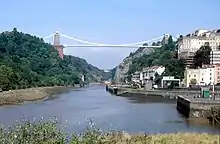.jpg.webp)
Bristol, the largest city in South West England, has an eclectic combination of architectural styles, ranging from the medieval to 20th century brutalism and beyond. During the mid-19th century, Bristol Byzantine, an architectural style unique to the city, was developed, and several examples have survived.
Buildings from most of the architectural periods of the United Kingdom can be seen throughout Bristol. Parts of the fortified city and castle date back to the medieval era, as do some churches dating from the 12th century onwards. Outside the historical city centre there are several large Tudor mansions built for wealthy merchants. Almshouses and public houses of the same period survive, intermingled with areas of more recent development. Several Georgian-era squares were laid out for the enjoyment of the middle class. As the city grew, it merged with its surrounding villages, each with its own character and centre, often clustered around a parish church.
The construction of the city's Floating Harbour, taking in the wharves on the River Avon and Frome, provided a focus for industrial development and the growth of the local transport infrastructure. Key elements of which include the Isambard Kingdom Brunel designed Clifton Suspension Bridge and Temple Meads terminus; the latter served from 2002 to 2009 as the British Empire and Commonwealth Museum, but is now closed.[1]
The 20th century saw further expansion of the city, the growth of the University of Bristol and the arrival of the aircraft industry. During World War II, the city centre was extensively bombed in the Bristol Blitz. The redevelopment of shopping centres, office buildings, and the harbourside continues to this day.
Medieval (11th – 14th century)
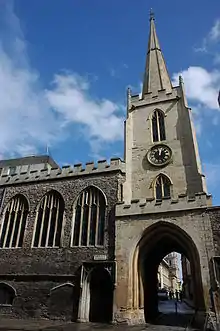
Defensive
The city was defended in medieval times by Bristol Castle, a Norman fortification built on the site of a wooden predecessor. The castle played a key role in the civil wars that followed the death of Henry I. Stephen of Blois reconnoitred Bristol in 1138 and claimed that the town was impregnable.[2] After Stephen's capture, in 1141, he was imprisoned in the castle.[3] The castle was later taken into royal hands,[4] and Henry III spent lavishly on it, adding a barbican before the main west gate, a gate tower, and a magnificent hall.[5] By the 16th century, the castle had fallen into disuse, but the city authorities had no control over royal property, and so the castle became a refuge for lawbreakers. In 1630, the city purchased the castle; Oliver Cromwell ordered its destruction in 1656.[6] An area outside the castle, known as Old Market, was used as a mustering point for troops. It later became a market for the country people to set up stalls and sell their wares. Old Market was also the site of an autumn fair.[7] The market may have existed as early as the 12th century, and was the site of the first suburb outside the city walls. It had side roads which could accommodate the traffic on market days.[8]
The city had extensive walls built by Geoffrey de Montbray, Bishop of Coutances. These have now largely disappeared, although parts remain on properties in King Street. A gateway in the old wall can now be seen under the tower of the Church of St John the Baptist.[9]
Religious
The earliest surviving church in Bristol is St James' Priory[10] in Horsefair, Whitson Street. It was founded in 1129, as a Benedictine priory, by Robert Rufus. The 12th century also saw the founding of All Saints[11] and St Philip and Jacob[12] churches.[9] Temple Church, now in ruins, was built on the site of the oval church of the Knights Templar, a Christian military order forcibly disbanded in 1312. Either just before or just after the disappearance of the Templars, the church was rebuilt on a rectangular plan and served as a parish church.[13]
Bristol Cathedral[14][15] was founded as St Augustine's Abbey in 1140 by Robert Fitzharding, along with its associated school, with the building works continuing in the Gothic style until about 1420. St Mark's Church was built around 1220.[16] Soon after, the foundations were laid for Holy Trinity Church in Westbury on Trym.[17] The 12th century also saw the foundation of St Mary Redcliffe,[18] renowned as one of the finest examples of the 15th century Perpendicular style, and the tallest building in the city. Elizabeth I, on a visit to the city in 1574, described it as the "fairest, goodliest and most famous parish church in England".[19] These 12th century churches were followed in the 14th century by the construction of Church of St John the Baptist[20] and St Stephen's Church.[21]
Westbury College was a 13th-century College of Priests located in Westbury-on-Trym. A gatehouse, now a National Trust property,[22] was added in the 15th century.
Tudor (15th – early 17th century)
The Tudor architectural period, which lasted from the late 15th century into the early 17th century, saw the development of large estates such as Ashton Court.[23] They were built for the local merchants, who gained much of their wealth from the trade passing through Bristol Harbour. Red Lodge was constructed in 1580 for John Yonge as the lodge for a great house that once stood on the site of the present Bristol Beacon.[24] In 1615, a number of houses were demolished for the development of the new Fishmarket.[25]
During the English Civil War, the Royal Fort was considered the strongest part of Bristol's defences, and it was to the fort that the Royalists retreated when they found themselves under siege from the Parliamentarians. It fell to the parliamentary forces in 1645 and was subsequently demolished.[26] St Nicholas's Almshouses were built in 1652[27] to provide care for the poor. Several public houses were also built in this period, including the Llandoger Trow[28] on King Street and the Hatchet Inn.[29] More churches were built, including St Michael on the Mount Without.[30] It served the St Michaels hill area, one of the first areas outside the city walls to be colonised by the wealthy merchants who were by then trying to escape the overcrowded and unhealthy conditions in the city centre.[8] The city was by this time beginning to expand rapidly beyond its traditional city walls, and the surrounding villages were starting to become suburbs, such as the villages of Horfield and Brislington. Both had their own churches, the Church of the Holy Trinity with St Edmund[31] and St Lukes[32] respectively.
Stuart (1666–1713)
The Stuart or English Baroque period (1666–1713) saw more expansion of the city. Large mansions such as Kings Weston House[33] and Goldney Hall[34] were constructed. The needs of the poor and destitute became the responsibility of institutions such as Colstons[35] and the Merchant Venturers Almshouses.[36] The King Street area was developed outside the "Back Street Gate" of the city, home to the King William and Naval Volunteer Public Houses.[37] The nearby Queen Square was planned during this era. In 1669, a series of four flights of steps, now called Christmas Steps, was constructed to replace a steep, muddy, and narrow street formerly known as Queene Street.[38][39] Many of the larger houses of this period, including Queen Square, were built for merchant families who were heavily involved in the slave triangle, importing goods from slave plantations. A few African and creole (American/Caribbean-born) slaves came to Bristol as servants.[40]
Georgian (18th to 19th century)
In 1732, John Strachan built Redland Court for John Cossins. It now forms one of the buildings making up Redland High School for Girls.[41] In 1760, the Bristol Bridge Act was carried through parliament by the Bristol MP Sir Jarrit Smyth.[42] That led to the demolition of St Nicholas's Gate, along with the original St Nicholas church, part of the Old Shambles, and thirty houses that stood on the old bridge.[25] The original bridge was a medieval wooden structure, lined with houses on both sides.[8] A 17th-century illustration shows that these were five stories high, including the attic rooms, and that they overhung the river much as Tudor houses would overhang the street.[43] At the time of the Civil War the bridge was noted for its community of goldsmiths, who may have been attracted by the unusually secure premises.[43] The current St Nicholas church was rebuilt in 1762–9 by James Bridges and Thomas Paty, who rebuilt the spire. Part of the old church and town wall survives in the 14th century crypt.[44]
The 1766 Theatre Royal, which claims to be the oldest continually operating theatre in England, joined with the Coopers' Hall, from 1744 and designed by architect William Halfpenny, to form the Bristol Old Vic.[45][46][47]
During the period of Georgian architecture (about 1720–1840) the main architects and builders working in Bristol were James Bridges, John Wallis, and Thomas Paty with his sons John and William Paty.[9] They put up hundreds of new buildings, reflecting the increased prosperity that came with the new Floating Harbour and trade based at The Exchange, built in 1741–43 by John Wood the Elder.[48][49][50] Their early work included the Royal Fort,[26] Blaise Castle House[51] and Arno's Court estate, with the associated Arno's Court Triumphal Arch[52] and Black Castle Public House.[53] More modest terraces and squares grew up in the new suburbs such as Hotwells[8] and north into Clifton, including 7 Great George Street, now the Georgian House Museum.[54] It was built around 1790 for John Pinney a successful sugar merchant, and is believed to be the house where the poets William Wordsworth and Samuel Taylor Coleridge first met.[55] It was also home to Pinney's slave, Pero, after whom Pero's Bridge at Bristol Harbour is named.[56]
In addition to evidence of the wealth brought by the slave trade there are several significant links to the abolitionists. Bristol's Hannah More was an influential member of the Society for Effecting the Abolition of the African Slave Trade. In the Seven Stars Public House Thomas Clarkson collected evidence for William Wilberforce on the cruelty of the trade in humans. Bristol Cathedral contains several memorials to people active in the abolition cause, including a bust of Robert Southey.[57] John Wesley opposed the trade in humans and in 1774 his sermon at the New Room against slavery was disturbed by explosion. Several plays adopted by the abolitionists were performed at the Bristol Old Vic, including Oroonoko, the story of an enslaved African and The Padlock, which was praised by Clarkson for its importance to the abolition cause.[58]
Several residential squares with terraces of three-storey houses were laid out around central gardens. An example is Portland Square, which was built between 1789 and 1820, and is now largely occupied by offices. In the 1830s, much of Queen Square was rebuilt following damage caused during the Bristol Riots,[59] and to the north of the city, Kings Square. The most fashionable areas were at the top of the hill, as in wet weather the cesspits overflowed down the hill.[8] Further development, though in a less formal manner, continued along the radial roads to Stokes Croft and Cheltenham, towards Horfield and in the St Phillips, Redcliffe and Bedminster areas.[8]
Religious needs in the expanding city were met for several denominations with Redland Chapel[60] and other Church of England buildings appearing, including Christ Church[61] and St Werburghs. Whitefield's Tabernacle, Kingswood was the first Methodist chapel[62] and a Quaker meeting house known as Quakers Friars was built in 1749.[63]
Regency (early 19th century)
The term Regency architecture refers primarily to buildings of the early 19th century, when George IV was still prince regent, and also to later buildings of the Victorian period which were designed in the same style. It follows closely on from the neo-classical Georgian style of architecture, adding an elegance and lightness of touch. Many buildings in the Regency style have a white painted stucco facade and an entryway to the main front door—usually coloured black—framed by two columns. Regency houses were typically built as terraces or crescents, often in a setting of trees and shrubs.[8] Elegant wrought iron balconies and bow windows were also fashionable. An instigator of this style was John Nash, whose most notable work in Bristol is Blaise Hamlet, a complex of small cottages surrounding a green. It was built around 1811, for the retired employees of Quaker banker and philanthropist John Scandrett Harford, who owned Blaise Castle House. The cottages are now owned by the National Trust.[64]
The Clifton and Cotham areas provide examples of the developments from the Georgian to the Regency style, with many fine terraces and villas facing the road, and at right angles to it. In the early 19th century, the romantic medieval gothic style appeared, partially as a backlash to the symmetry of Palladianism, and can be seen in buildings such as Bristol City Museum and Art Gallery,[65] Royal West of England Academy,[66] and The Victoria Rooms.[67] St Mary on the Quay church was built between 1839 and 1843, by Richard Shackleton Pope, as a Catholic apostolic chapel for the Irvingite congregation: it is now a Roman Catholic church.[68]
Victorian (late 19th century)
The Victorian era saw further expansion of the city, both in its industrial heartland around the docks and in the suburbs, particularly in Clifton.
Palatial squares were developed for the prosperous middle classes. Italianate and Grecian villas, made with Bath Stone and sitting in their own gardens, were built in areas such as Clifton Down. At the same time, hundreds of acres of working class and artisan homes were built, especially in the south and east of the city.[8] To support the growing population, public service buildings such as the Beaufort Hospital (now Glenside), schools such as Clifton College and public houses such as the Mauretania Public House were constructed.[69]
Between 1849 and 1870, five large stone buildings were erected by George Müller to care for 2,050 orphans in his Ashley Down orphanage.[70]
Cabot Tower is situated in a public park on Brandon Hill. It was built in 1897 by William Venn Gough in memory of John Cabot, 400 years after he set sail from Bristol and landed on what is now Canada.[71]
Industrial
A notable feature of Bristol's architecture is the Bristol Byzantine style.[72] Characterised by complicated polychrome brick and decorative arches, this style was used in the construction of factories, warehouses and municipal buildings built in the Victorian era. Surviving examples include the Colston Hall,[73] the Granary on Welsh Back, and the Gloucester Road Carriage Works,[74] along with some of the buildings around Victoria Street. Several of the warehouses around the harbour have also survived, including the Arnolfini, which now houses an art gallery.[75] Clarks Wood Company warehouse,[76] the St Vincent's Works[77] in Silverthorne Lane, and the Wool Hall[78] in St Thomas Street, are other survivors from the 19th century.
The local Pennant sandstone is frequently used as walling material, often with limestone dressings, as found on the old Temple Meads railway station[79] and Clifton Down railway station.[80] Pennant sandstone is also used as large rock-faced squared blocks, described as Pennant rubble, which are used alone, eked out with plain brickwork, or incorporated into the more rugged examples of Bristol Byzantine. Much of the local transport infrastructure including the Clifton Suspension Bridge and the original Temple Meads railway station—now used as the British Empire and Commonwealth Museum—were designed or built by Isambard Kingdom Brunel.[81]
In 1864, after over 100 years of planning, the Clifton Suspension Bridge[82] over the Avon Gorge linked the city to the Ashton Court estate. However, development to the west of the River Avon remained limited.
Edward Everard's printing works with its detailed ceramic frontage was constructed in 1900.
20th century
In the early part of the 20th century further expansion took place in residential districts increasingly distant from the city centre. Bristol Hippodrome was designed by Frank Matcham, and opened on 16 December 1912.[83]
The Wills Memorial Building was commissioned in 1912 by George Alfred Wills and Henry Herbert Wills, the magnates of the Bristol tobacco company W. D. & H. O. Wills, in honour of their father, Henry Overton Wills III, benefactor and first Chancellor of the University of Bristol. Sir George Oatley was chosen as architect and told to "build to last". He produced a design in the Perpendicular Gothic style, to evoke the famous university buildings of Oxford and Cambridge.[84][85][86] The university also took over several existing houses such as Royal Fort,[26] Victoria Rooms,[67] Clifton Hill House,[87] Goldney Hall,[34] Wills Hall[88] and buildings on Berkeley Square,[89][90][91] Park Street and the surrounding areas. Oatley was also involved in the design or restoration of other buildings in Bristol in the early part of the 20th century, including the restoration of John Wesley's original Methodist chapel, the New Room.[92][93]
The 1930s saw the construction of the Employment Exchange and the planning of the new Council House, although this was not completed until 1956.[94] As a centre of aircraft manufacturing, Bristol was a target for bombing during the Bristol Blitz of World War II.[95] Bristol's city centre was severely damaged, especially in November and December 1940, when the Broadmead area was flattened, and Hitler claimed to have destroyed the city.[96] The original central area, near the bridge and castle, is now a park featuring two bombed-out churches and fragments of the castle. A third bombed church has been given a new lease of life as the St Nicholas' Church Museum. Slightly to the north, the Broadmead shopping centre was built over bomb-damaged areas. Clifton Cathedral, to the north of the city centre, was built during the early 1970s.

Like much of British post-war development, the regeneration of Bristol city centre was characterised by Modernist architecture including Brutalist towers such as Castlemead - one of several notable examples of brutalist architecture[97] in the city, and improvement and expansion to road infrastructure. The world's oldest shot tower in Redcliffe was lost to road development in 1968, being replaced the following year by the Cheese Lane Shot Tower on a different site. Since the 1990s this trend has been reversing, limiting access with the closure of a number of main roads, whilst the Broadmead shopping centre has been further developed. In 2006, one of the city centre's tallest Mid-Century Modern towers was lost, with further historic 20th century structures being destroyed more recently. The transfer of the docks to Avonmouth, 7 miles (11 km) downstream from the city centre, relieved congestion in the centre of Bristol and allowed substantial redevelopment of the old central dock area (the Floating Harbour). The continued existence of the central docks was for some time in jeopardy, as they were seen to be remnants of a derelict industry instead of an asset to be developed for public use.
In 1958, Barton House,Bristol's first tower block was built.[98]
In the 1990s, a harbourside concert hall designed by architects Behnisch & Partners was planned, but an Arts Council decision cut the funding and the project has not been revived.[99] This has left We The Curious (formerly At-Bristol), which mixes art, science and nature, with its all-reflective planetarium, as the centrepiece of the Harbourside development.[100]
21st century

The Broadmead shopping centre was redeveloped in the early years of the century, involving the demolition of one of the city's tallest mid-century towers, Tollgate House, in the construction of Cabot Circus.[101] The former Bristol and West Tower was reworked into a glass skyscraper with glass panels in place of its concrete outer cladding. In 2005, the city council undertook extensive consultations about the future of tall buildings in Bristol, and identified support for new tall buildings so long as they are well designed, sustainable, distinctive and 'fit' into the existing urban landscape.[102]
In May 2007, proposals were announced to build approximately 753,000 square feet (70,000 m2) net of homes, offices, and business premises in the St Pauls area. The development, if it had been approved, would have included a 600 feet (183 m), 40-storey tower next to the M32 motorway, acting as a new entrance to the city. The tower would have been a similar shape to the Swiss Re "Gherkin" tower in London.[103]
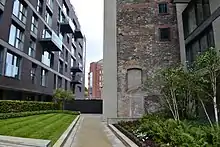
Planning for the large Finzels Reach development across the Floating Harbour from Castle Park, including the old Georges Brewery buildings, was first granted in 2006 but progress was hampered by the recession and the developers went into receivership.[104] By 2015 the development is part complete with the historic waterfront facade still awaiting regeneration.[105] Since 2013, Bristol has seen an increase in buildings being built or office blocks being converted for student accommodation. These include Froomsgate House, St. Lawrence House (a former office block) in Broad Street, the former Magistrates Court site and New Bridewell Tower.[106]
Tallest buildings
A roster of the tallest buildings constructed in Bristol includes:[107]
| Rank | Building | Area | Height | Floors | Built | |
|---|---|---|---|---|---|---|
| m | ft | |||||
| 1 | St Mary Redcliffe | Redcliffe | 89 | 292 | Completed 15th century | |
| 2 | Castlemead | Lower Castle Street | 80 | 262 | 19 | 1973-1981 |
| 3 | Wills Memorial Building | UoB, Clifton | 66 | 217 | 1925 | |
| 4 | Christ Church | Clifton | 65 | 213 | 1885 | |
| 5 | Eclipse | Harvey Nichols | 65 | 213 | 14 | 2008 |
| 6 | Avon House | Haymarket | 64 | 210 | 18 | 1972 |
| 7 | Beacon Tower | Colston Avenue | 63 | 207 | 18 | 1973 |
| 8 | Froomsgate House | Rupert Street | 63 | 207 | 15 | 1971 |
| 9 | Former Bristol and West Building | Marsh Street | 61 | 200 | 17 | 1967 |
| 10 | One Redcliff Street | Bristol Bridge | 60 | 197 | 15 | 1964 |
| 11 | Greyfriars | Lewin's Mead | 59 | 194 | 14 | 1974 |
See also
References
- ↑ "Empire and Us". British Empire & Commonwealth Museum. Archived from the original on 28 February 2011. Retrieved 2 March 2011.
- ↑ Potter, K. R.; R.H.C. Davis (1976). Gesta Stephani (Oxford Medieval Texts) (pp. 37–8, 43–4.). Oxford: Clarendon Press. ISBN 0-19-822234-3.
- ↑ Potter, K.R. (1998). William of Malmesbury — Historia Novella: The Contemporary History (Oxford Medieval Texts) (p. 50). Oxford: Clarendon Press. ISBN 0-19-820192-3.
- ↑ Sharp, Margaret (1982). Accounts of the Constables of Bristol Castle in the Thirteenth and Early Fourteenth Centuries (p. xviii.). Bristol Record Society.
- ↑ Colvin, H.M. (1971). Building Accounts of Henry III. Oxford: Oxford University Press. ISBN 0-19-920013-0.
- ↑ Stone, George Frederick (1909). Bristol as it was and as it is, a record of 50 years' progress (p. 99.). Bristol: Walter Reid.
- ↑ "Old Market". About Bristol. Retrieved 21 May 2007.
- 1 2 3 4 5 6 7 8 Bown, Dorothy (1974). Bristol and how it grew. Bristol: Bristol Visual & Environmental Group, with the help of a grant from the South West Arts Association. ISBN 0-9504648-2-1.
- 1 2 3 Burrough, T. H. B. (1970). Bristol. London: Studio Vista. ISBN 0-289-79804-3.
- ↑ "Church of St James". historicengland.org.uk. Historic England. Retrieved 25 October 2006.
- ↑ "Church of All Saints". historicengland.org.uk. Historic England. Retrieved 16 March 2007.
- ↑ "Church of St Philip and St Jacob". historicengland.org.uk. Historic England. Retrieved 16 March 2007.
- ↑ "Temple Church". historicengland.org.uk. Historic England. Retrieved 28 July 2006.
- ↑ Joseph Bettey, St Augustine's Abbey, Bristol (Bristol Branch of the Historical Association 1996), pp.1, 5, 7.
- ↑ "Cathedral Church of St Augustine, including Chapter House and cloisters". historicengland.org.uk. Historic England. Retrieved 16 March 2007.
- ↑ "Church of St Mark, Lord Mayor's Chapel". historicengland.org.uk. Historic England. Retrieved 16 March 2007.
- ↑ "Church of the Holy Trinity". historicengland.org.uk. Historic England. Retrieved 16 March 2007.
- ↑ "Church of St Mary Redcliffe". historicengland.org.uk. Historic England. Retrieved 16 March 2007.
- ↑ "Bristol / architecture". The Guardian. London. Archived from the original on 28 September 2007. Retrieved 27 March 2007.
- ↑ "Church of St John the Baptist and St John's Gate". historicengland.org.uk. Historic England. Retrieved 16 March 2007.
- ↑ "Church of St Stephen". historicengland.org.uk. Historic England. Retrieved 16 March 2007.
- ↑ "Westbury College and College House". historicengland.org.uk. Historic England. Retrieved 16 March 2007.
- ↑ "Ashton Court Mansion and Stables". historicengland.org.uk. Historic England. Retrieved 16 March 2007.
- ↑ "Red Lodge and attached rubble walls and entrance steps". historicengland.org.uk. Historic England. Retrieved 10 March 2007.
- 1 2 "Architecture:From Hovel to Tower". About Bristol. Archived from the original on 26 June 2007. Retrieved 27 March 2007.
- 1 2 3 "Royal Fort and attached front step railings". historicengland.org.uk. Historic England. Retrieved 24 March 2007.
- ↑ "St Nicholas' Almshouses, Nos.1–10". historicengland.org.uk. Historic England. Retrieved 21 February 2007.
- ↑ "Llandoger Trow". historicengland.org.uk. Historic England. Retrieved 22 February 2007.
- ↑ "No.1 The Palace Hotel". historicengland.org.uk. Historic England. Retrieved 15 May 2007.
- ↑ "Church of St Michael and attached railings". historicengland.org.uk. Historic England. Retrieved 16 March 2007.
- ↑ "Church of the Holy Trinity with St Edmund". historicengland.org.uk. Historic England. Retrieved 16 March 2007.
- ↑ "Church of St Luke". historicengland.org.uk. Historic England. Retrieved 16 March 2007.
- ↑ "Kings Weston House". historicengland.org.uk. Historic England. Retrieved 16 March 2007.
- 1 2 "Goldney House and attached walls". historicengland.org.uk. Historic England. Retrieved 16 March 2007.
- ↑ "Colstons Almshouses". historicengland.org.uk. Historic England. Retrieved 16 March 2007.
- ↑ "Merchant Venturers' Almshouses". historicengland.org.uk. Historic England. Retrieved 21 February 2007.
- ↑ "King William and Naval Volunteer Public Houses". historicengland.org.uk. Historic England. Retrieved 22 February 2007.
- ↑ "Christmas Steps". About Bristol. Archived from the original on 26 July 2007. Retrieved 13 May 2007.
- ↑ "history". Christmas Steps. Archived from the original on 6 February 2007. Retrieved 13 May 2007.
- ↑ "The City Docks, Bristol...the slavery trail". History Footsteps from the Victoria County History. Archived from the original on 28 August 2007. Retrieved 4 September 2007.
- ↑ "Redland Court (Redland High School)". historicengland.org.uk. Retrieved 13 March 2007.
- ↑ Bantock, Anton (2004) Ashton Court, ISBN 0-7524-3213-3, p. 29
- 1 2 Lynch, John (1999). For King & Parliament. Stroud, Gloucestershire: Sutton Pub. ISBN 0-7509-2021-1.
- ↑ "City Museum, former Church of St Nicholas". historicengland.org.uk. Retrieved 16 March 2007.
- ↑ "The Theatre Royal". historicengland.org.uk. Retrieved 16 March 2007.
- ↑ "The Coopers' Hall". historicengland.org.uk. Retrieved 16 March 2007.
- ↑ McGrath, Patrick (1972). Bristol in the Eighteenth Century. David & Charles PLC. ISBN 0-7153-5726-3.
- ↑ Haddon, John (1981). Portrait of Avon. London: Robert Hale Ltd. ISBN 0-7091-8361-5.
- ↑ Dr Roger H. Leech (May 1999). "Historical and Architectural Survey and Analysis of The Exchange, Corn Street, Bristol" (PDF). Archived from the original (PDF) on 30 September 2007. Retrieved 1 February 2007.
- ↑ Little, Bryan (1967). The city and county of Bristol. Wakefield: SR Publishing. ISBN 0-85409-512-8.
- ↑ "Blaise Castle House and attached wall". historicengland.org.uk. Retrieved 13 March 2007.
- ↑ "Arno's Court Triumphal Arch". historicengland.org.uk. Historic England. Retrieved 16 March 2007.
- ↑ "Black Castle Public House". historicengland.org.uk. Retrieved 16 March 2007.
- ↑ "The Georgian House, attached front area railings and rear garden walls". historicengland.org.uk. Historic England. Retrieved 14 March 2007.
- ↑ "Georgian House". Homes and Gardens. Archived from the original on 6 March 2007. Retrieved 14 March 2007.
- ↑ "Bristol's Georgian House". Bristol Museums. Archived from the original on 5 April 2007. Retrieved 14 March 2007.
- ↑ "In the footsteps of Bristol's abolitionists". BBC Bristol. Archived from the original on 17 October 2009. Retrieved 17 October 2007.
- ↑ "In the footsteps of Bristol's abolitionists". BBC Bristol. Archived from the original on 17 October 2009. Retrieved 4 September 2007.
- ↑ Foyle, Andrew (2004). Bristol Pevsner Architectural Guides. Yale University Press. ISBN 978-0300104424.
- ↑ "Redland Chapel". historicengland.org.uk. Historic England. Retrieved 9 July 2006.
- ↑ "Christ Church with St Ewen". historicengland.org.uk. Retrieved 16 March 2007.
- ↑ "Whitfield's Tabernacle". historicengland.org.uk. Historic England. Retrieved 13 March 2007.
- ↑ "Quaker meeting house, now registry office". historicengland.org.uk. Historic England. Retrieved 16 March 2007.
- ↑ "Blaise Hamlet". National Trust. Archived from the original on 8 November 2015. Retrieved 21 November 2015.
- ↑ "City Museum and Art Gallery and attached front walls". historicengland.org.uk. Retrieved 10 March 2007.
- ↑ "Royal West of England Academy". historicengland.org.uk. Historic England. Retrieved 9 May 2006.
- 1 2 "Victoria Rooms and attached railings and gates". historicengland.org.uk. Historic England. Retrieved 23 March 2007.
- ↑ "Church of St Mary-on-the-Quay". historicengland.org.uk. Historic England. Retrieved 16 March 2007.
- ↑ "The Mauretania Public House". historicengland.org.uk. Historic England. Retrieved 19 February 2007.
- ↑ "Ashley George Muller's Orphanage". About Bristol. Retrieved 10 September 2010.
- ↑ "Cabot Tower". historicengland.org.uk. Historic England. Retrieved 13 March 2007.
- ↑ "Bristol Byzantine". Looking at Buildings. Archived from the original on 27 September 2007. Retrieved 18 May 2007.
- ↑ "The Colston Hall". historicengland.org.uk. Historic England. Retrieved 13 March 2007.
- ↑ "No.104 The Carriage Works". historicengland.org.uk. Historic England. Retrieved 2 May 2007.
- ↑ "Bush House". historicengland.org.uk. Historic England. Retrieved 18 August 2006.
- ↑ "Clarks Wood Company warehouse". historicengland.org.uk. Retrieved 15 May 2007.
- ↑ "St Vincent's Works and attached front area railings". historicengland.org.uk. Historic England. Retrieved 2 May 2007.
- ↑ "No.12 The Wool Hall, including the Fleece and Firkin Public House". historicengland.org.uk. Historic England. Retrieved 12 May 2007.
- ↑ "Temple Meads Station". historicengland.org.uk. Retrieved 16 March 2007.
- ↑ "Clifton Down Station, Steam Tavern Public House and attached screen walls". historicengland.org.uk. Retrieved 24 March 2007.
- ↑ "Bristol Old Station, Temple Meads". historicengland.org.uk. Retrieved 13 March 2007.
- ↑ "Clifton Suspension Bridge". historicengland.org.uk. Retrieved 9 May 2006.
- ↑ "The Hippodrome". historicengland.org.uk. Retrieved 21 March 2007.
- ↑ "New Chapter for the Wills Memorial Building". University of Bristol. Archived from the original on 22 November 2015. Retrieved 21 November 2015.
- ↑ "Wills Memorial Building". University of Bristol, Centre for Romantic Studies. Archived from the original on 27 June 2006. Retrieved 18 March 2006.
- ↑ "University Tower and Wills Memorial Building and attached front walls and lamps". historicengland.org.uk. Retrieved 13 March 2007.
- ↑ "Clifton Hill House and attached front walls". historicengland.org.uk. Retrieved 14 March 2007.
- ↑ "Wills Hall". historicengland.org.uk. Retrieved 13 March 2007.
- ↑ "Nos.1–8 (Consecutive) and attached railings and gates". historicengland.org.uk. Retrieved 22 February 2007.
- ↑ "Nos.11–19 (Consecutive) and attached railings". historicengland.org.uk. Retrieved 22 February 2007.
- ↑ "Nos.20–30 (Consecutive) and attached railings and gates". historicengland.org.uk. Retrieved 22 February 2007.
- ↑ "64.The New Room, Bristol". Methodist Conference. Archived from the original on 9 October 2007. Retrieved 31 March 2007.
- ↑ "Wesley's New Room". Looking at Buildings from the Pevsner Architectural Guides. Archived from the original on 27 September 2007. Retrieved 31 March 2007.
- ↑ "Council House and attached railings and piers". historicengland.org.uk. Retrieved 21 August 2006.
- ↑ "Overview". Bristol Blitzed. Archived from the original on 17 May 2007. Retrieved 7 March 2007.
- ↑ Pictorial history of Bristol, bristolhistory.com. Retrieved 14 April 2006.
- ↑ "Bristol Brutalism - Best Brutalist Architecture in Bristol". The Spoonster Spouts. 1 April 2019. Retrieved 25 April 2020.
- ↑ Booth, Martin (15 November 2023). "Hundreds of residents evacuated from Bristol's oldest tower block". Bristol24/7. Retrieved 15 November 2023.
- ↑ Hencke, David; Gibbons, Fiachra (20 January 2000). "Arts council a bottomless pit, say MPs". The Guardian. Archived from the original on 3 February 2016. Retrieved 27 January 2016.
- ↑ "Bristol/architecture". The Guardian. Archived from the original on 28 September 2007. Retrieved 27 March 2007.
- ↑ "Demolition of city tower begins". BBC News. 13 January 2006. Archived from the original on 5 February 2007. Retrieved 10 March 2007.
- ↑ "Height Matters — Consultation on tall buildings in Bristol". Bristol City Council. Archived from the original on 30 September 2007. Retrieved 15 July 2007.
- ↑ "Supplementary Planning Document 1. Tall Buildings". Bristol City Council. p. 29. Archived from the original on 21 September 2017. Retrieved 21 September 2017.
- ↑ "BBC Regional News Finzels Reach receivership". BBC News. 25 April 2013. Archived from the original on 5 June 2013. Retrieved 31 October 2015.
- ↑ "Finzels Reach News Page update". Archived from the original on 22 November 2015. Retrieved 31 October 2015.
- ↑ Clensy, David (5 April 2017). "Tall buildings in Bristol being dwarfed by other major cities". Bristol Post. Retrieved 21 September 2017.
- ↑ Emporis Buildings Archived 22 November 2015 at the Wayback Machine. Emporis.com. Retrieved 21 November 2015.
Further reading
- Buchanon, R.A.; Neil Cossons (1969). Industrial Archaeology of the Bristol Region. David & Charles PLC. ISBN 0-7153-4394-7.
- Ison, Walter (1978). The Georgian Buildings of Bristol. AvonAnglia. ISBN 0-901571-88-1.
- Leech, Roger (2000). "The Topography of Medieval Bristol". Bristol Record Society. 51: 396–422.
- Priest, Gordon (2003). The Paty Family: Makers of Eighteenth-century Bristol. Redcliffe Press Ltd. ISBN 1-900178-54-0.
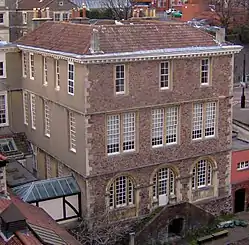

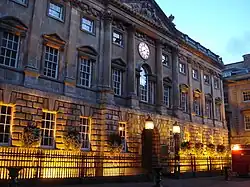
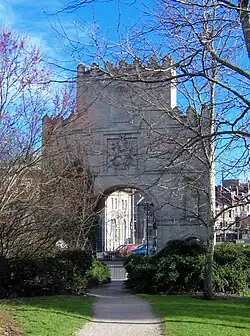
.jpg.webp)


